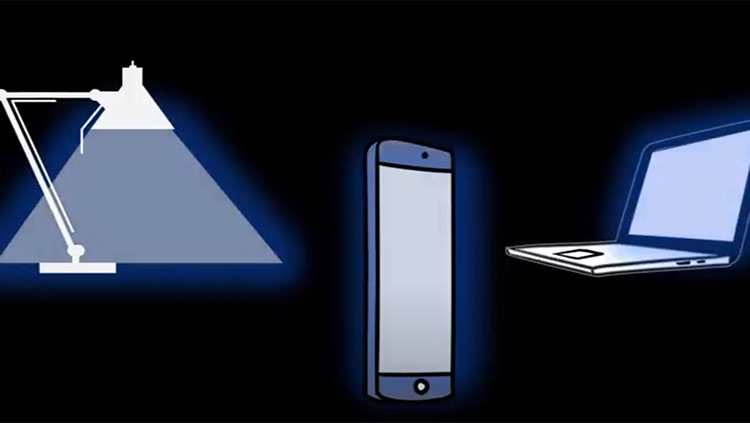Disorders Disturbing Healthy Slumber
- Reviewed15 Aug 2022
- Author Melissa Galinato
- Source BrainFacts/SfN

For some, getting enough sleep is a struggle. All efforts to follow a regular sleep regimen fail to provide balance to their sleep-wake cycles. For others, the challenge is staying awake. Sleep disorders take on many different forms; however, all disrupt our natural sleep-wake cycles.
The most common sleep disorder, and the one most people are familiar with, is insomnia. Some people with insomnia have difficulty falling asleep initially; others fall asleep, then awaken part way through the night and can’t fall back asleep. Several common disorders disrupt sleep and prevent people from getting an adequate amount of sleep.
Daytime sleepiness, characterized by excessive feelings of tiredness during the day, has many causes, and increases the risk of daytime accidents, especially car accidents.
Sleep apnea occurs when the airway muscles of the throat relax during sleep, to the point of collapse, closing the airway. People with sleep apnea have difficulty breathing and wake up without entering the deeper stages of slow wave sleep (SWS). This condition can cause high blood pressure and may increase the risk of heart attack. Treatments for sleep apnea focus on reducing airway collapse during sleep; simple changes that may help include losing weight, avoiding alcohol or sedating drugs prior to sleep, and avoiding sleeping on one’s back. However, most people with sleep apnea require breathing machines to keep their airway open. One such device, called a continuous positive airway pressure or “CPAP” machine, uses a small mask that fits over the nose to provide an airstream under pressure during sleep. In some cases, people need surgery to correct their airway anatomy.
Rapid eye movement (REM) sleep behavior disorder occurs when nerve pathways in the brain that prevent muscle movement during REM sleep do not work. Remember that dreaming happens during REM sleep, so imagine people literally acting out their dreams by getting up and moving around. This can be very disruptive to a normal night’s sleep. The cause of REM behavior disorder is unknown, but it is more common in people with degenerative neurological disease such as Parkinson’s, stroke, and types of dementia. The disorder can be treated with drugs for Parkinson’s or with a benzodiazepine drug, clonazepam, which enhances the effects of the inhibitory neurotransmitter gamma-aminobutyric acid (GABA).
Narcolepsy: An Example of Sleep Disorder Research
Narcolepsy is a relatively uncommon sleep disorder — only 1 case per 2,000 people in the United States — in which the brain lacks the special neurons that help control the transition into sleep. As a result, regular sleep cycling is disrupted. People with narcolepsy have sleep attacks during the day, causing them to suddenly fall asleep, which is especially dangerous if they are driving. The problem is caused by the loss of orexin neurons in the lateral hypothalamus. People with narcolepsy tend to enter REM sleep very quickly and may even enter a dreaming state while still partially awake, a condition known as hypnagogic hallucination. Some people with narcolepsy also have attacks in which they lose muscle tone — similar to what happens in rapid eye movement (REM) sleep, but while they’re awake. These attacks of paralysis, known as cataplexy, can be triggered by emotional experiences and even by hearing a funny joke.
Research into the mechanisms of narcolepsy has provided important insights into the processes that control the transitions between waking, slow wave sleep, and REM sleep states. Orexin (in the lateral hypothalamus) is critical for preventing abnormal transitions into REM sleep during the day. In one study, scientists inactivated the gene for orexin in mice and measured their sleep patterns. They found that mice lacking the orexin gene showed symptoms of narcolepsy. Similarly, humans with narcolepsy have abnormally low levels of orexin levels in their brain and spinal fluid.
Because orexin levels are disrupted in narcolepsy, scientists also began studying neurons that were neighbors to orexin neurons to see what happened if the neighboring neurons were activated in narcoleptic mice. Those neurons contained melanin-concentrating hormone, and stimulating them (using a technique called optogenetics) induced sleep — opposite to the effect of stimulating orexin neurons. A balance between the activation of orexin neurons and their neighboring neurons could control the transition between waking and sleeping. These findings will be important in developing treatments for narcolepsy.
Adapted from the 8th edition of Brain Facts by Melissa Galinato.
CONTENT PROVIDED BY
BrainFacts/SfN
References
Allan, H. J., & Robert, M. (1997). The brain as a dream state generator: an activation-synthesis hypothesis of the dream process. Am J Psychiatr, 134, 1335-1348. https://pdfs.semanticscholar.org/f1af/886bfac2ee058ddaf1a6fb61dabe08e19b08.pdf
Becchetti, A., & Amadeo, A. (2016). Why we forget our dreams: Acetylcholine and norepinephrine in wakefulness and REM sleep. Behavioral and Brain Sciences, 39. https://www.cambridge.org/core/journals/behavioral-and-brain-sciences/article/div-classtitlewhy-we-forget-our-dreams-acetylcholine-and-norepinephrine-in-wakefulness-and-rem-sleepdiv/9C71B973B2BE9F117C17042BC0B43E7E
Carskadon, M.A., & Dement, W.C. (2011). Monitoring and staging human sleep. In M.H. Kryger, T. Roth, & W.C. Dement (Eds.), Principles and practice of sleep medicine, 5th edition, (pp 16-26). St. Louis: Elsevier Saunders. https://www.ninds.nih.gov/Disorders/Patient-Caregiver-Education/Fact-Sheets/Narcolepsy-Fact-Sheet
Chemelli, R. M., Willie, J. T., Sinton, C. M., Elmquist, J. K., Scammell, T., Lee, C. ... & Fitch, T. E. (1999). Narcolepsy in orexin knockout mice: molecular genetics of sleep regulation. Cell, 98(4), 437-451. http://www.sciencedirect.com/science/article/pii/S009286740081973X
Konadhode, R. R., Pelluru, D., & Shiromani, P. J. (2014). Neurons containing orexin or melanin concentrating hormone reciprocally regulate wake and sleep. Frontiers in systems neuroscience, 8. https://www.ncbi.nlm.nih.gov/pmc/articles/PMC4287014/
McEwen, B. S., & Karatsoreos, I. N. (2015). Sleep deprivation and circadian disruption: stress, allostasis, and allostatic load. Sleep medicine clinics, 10(1), 1-10. http://www.sciencedirect.com/science/article/pii/S1556407X14001246
Pelluru, D., Konadhode, R., & Shiromani, P. J. (2013). MCH neurons are the primary sleep-promoting group. Sleep, 36(12), 1779-1781. https://academic.oup.com/sleep/article/36/12/1779/2709396/MCH-Neurons-Are-the-Primary-Sleep-Promoting-Group
Schwartz, M. D., & Kilduff, T. S. (2015). The neurobiology of sleep and wakefulness. Psychiatric Clinics of North America, 38(4), 615-644. http://europepmc.org/articles/pmc4660253
Shiromani, P., Konadhod, R., Pelluru, D., Blanco-Centurion, C., Liu, M., & Mulholland, P. (2013). Optogenetic activation of specific neurons to ameliorate symptoms of narcolepsy in mice. Sleep Medicine, 14, e46-e47. http://www.sciencedirect.com/science/article/pii/S1389945713012896
Tsunematsu, T., Tabuchi, S., Tanaka, K. F., Boyden, E. S., Tominaga, M., & Yamanaka, A. (2013). Long-lasting silencing of orexin/hypocretin neurons using archaerhodopsin induces slow-wave sleep in mice. Behavioural brain research, 255, 64-74. http://www.sciencedirect.com/science/article/pii/S0166432813002921
Verweij, I. M., Romeijn, N., Smit, D. J., Piantoni, G., Van Someren, E. J., & van der Werf, Y. D. (2014). Sleep deprivation leads to a loss of functional connectivity in frontal brain regions. BMC neuroscience, 15(1), 88. https://bmcneurosci.biomedcentral.com/articles/10.1186/1471-2202-15-88
What to Read Next
Also In Sleep
Trending
Popular articles on BrainFacts.org


















